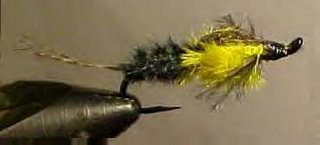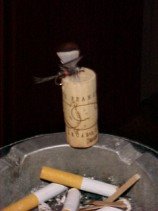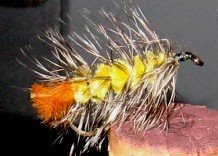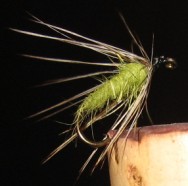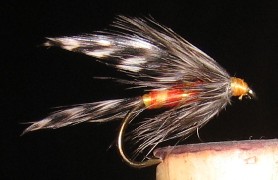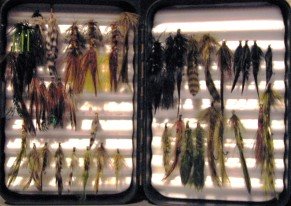 The folks on the South Fork of the Snake River have one set of flies, the folks on the Lamar River have another set, the folks on the Yellowstone River have their favorites, and the Madison River drainage yet others. This is not too surprising - yet many a congenial brew has been ruined discussing the "CORRECT FLIES."
The folks on the South Fork of the Snake River have one set of flies, the folks on the Lamar River have another set, the folks on the Yellowstone River have their favorites, and the Madison River drainage yet others. This is not too surprising - yet many a congenial brew has been ruined discussing the "CORRECT FLIES.".. Between our time spent in the neighborhood and traveling, we have developed a comprehensive collection of generalized Fall flies. They work most places, and are not at all out of the ordinary. There are a few local variants, and a few old-timer's. They are not necessarily "Correct," and certainly not perfect. They are, however, consistently successful.
.. These are the flies that we would fish until the folks 200 yards down the river gave us a fly that just caught more fish than we did. That's how we gathered up most of these flies in the first place.
.. The Dark Spruce Fly is a must for Fall fishing in Yellowstone.

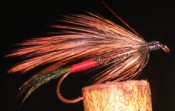 It can be tied in a traditional, streamer style, or as a Matuka. We use both. We also tend to use flies that are a bit bigger than the conventional wisdom dictates. There seems to be a subconscious message in our hard-wiring; "size matters." We also prefer furnace hackle with a touch of green - if we can get it.
It can be tied in a traditional, streamer style, or as a Matuka. We use both. We also tend to use flies that are a bit bigger than the conventional wisdom dictates. There seems to be a subconscious message in our hard-wiring; "size matters." We also prefer furnace hackle with a touch of green - if we can get it... The Light Spruce Fly is carried by most

 folks in the neighborhood. They fish it less than the dark one. It too, can be tied in either style. Again we prefer a darker and off-color wing to the stark white of the traditional recipe. It is almost a sure thing that any fall fisher will have this fly in the box come Labor Day.
folks in the neighborhood. They fish it less than the dark one. It too, can be tied in either style. Again we prefer a darker and off-color wing to the stark white of the traditional recipe. It is almost a sure thing that any fall fisher will have this fly in the box come Labor Day. .. The Yellowstone Spruce Fly is tied in a manner similar to the dark and light varieties. It uses materials that are at variance with the traditional recipes and is probably not a "real" Spruce Fly. It has a small but dedicated following among old-fart-fishers along the Henry's Fork, Madison, Firehole, and Gibbon Rivers. This streamer has two variants. The one shown here is the most popular. The other uses a green under wing with a yellow body and green butt. We fish this one, other folks use the other one - they both catch fish.
.. The Yellowstone Spruce Fly is tied in a manner similar to the dark and light varieties. It uses materials that are at variance with the traditional recipes and is probably not a "real" Spruce Fly. It has a small but dedicated following among old-fart-fishers along the Henry's Fork, Madison, Firehole, and Gibbon Rivers. This streamer has two variants. The one shown here is the most popular. The other uses a green under wing with a yellow body and green butt. We fish this one, other folks use the other one - they both catch fish. .. The Green Matuka Egg Fly is reappearing in many fly boxes. This was a popular fly 15 years ago on the South Fork of the Snake River. It is seeing use on the Madison and Firehole Rivers right now. It's just a Matuka - tied a little long. Some use red for the egg, some use florescent orange, some use yellow - don't seem to matter much.
.. The Green Matuka Egg Fly is reappearing in many fly boxes. This was a popular fly 15 years ago on the South Fork of the Snake River. It is seeing use on the Madison and Firehole Rivers right now. It's just a Matuka - tied a little long. Some use red for the egg, some use florescent orange, some use yellow - don't seem to matter much.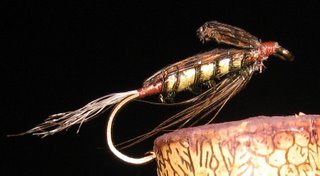 .. The Yellowstone Sally is generally tied in Stone fly sizes for spring fishing. When tied on a long shank hook, with a long tail, it's a very durable and serviceable streamer - of sorts. It is best in the early Fall, (like right now,) and seems to lose it's appeal as winter approaches.
.. The Yellowstone Sally is generally tied in Stone fly sizes for spring fishing. When tied on a long shank hook, with a long tail, it's a very durable and serviceable streamer - of sorts. It is best in the early Fall, (like right now,) and seems to lose it's appeal as winter approaches... The Black Ghost, Black Nose Dace, Mickey Finn, and Hellifiknow, are all used in the Fall for the lake run fish on their spawning trip up the Madison River.
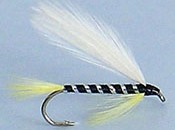
 These are excellent flies for the big plunge pool at the base of Gibbon Falls. They also work in the very early morning or late evening on the Gallatin River in the deep dark pools.
These are excellent flies for the big plunge pool at the base of Gibbon Falls. They also work in the very early morning or late evening on the Gallatin River in the deep dark pools.
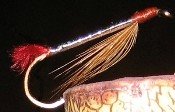 These are usually tied very sparsely and fished deep on a dead drift. They serve as both searching flies and as mid-day flies, (the tinsel seems to be the key - or the contrast - or . . .)
These are usually tied very sparsely and fished deep on a dead drift. They serve as both searching flies and as mid-day flies, (the tinsel seems to be the key - or the contrast - or . . .).. There are quite a few similar flies that are bright with tinsel; and when they work - they really work. When they don't - they really don't. There must be a lesson here, but we haven't figured it out - yet.
.. The Gray Ghost in either it's classic form,
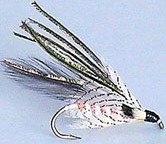 as tied by Stevens, or it's shorter-shanked commercial versions is creeping back into the fly boxes of the Fall fishers in Yellowstone National Park. Most of the visitors, when asked, explain that they use it because they like it. The neighbors have a different reason - ". . . tried everything else." This fly is usually fished on a mended swing. Make it as slow as you can and mend and back-strip to keep it as drag free as possible - a strip-set is usually required when the take happens. If fished too far away it is probably mouthed and rejected -- and you'll never know.
as tied by Stevens, or it's shorter-shanked commercial versions is creeping back into the fly boxes of the Fall fishers in Yellowstone National Park. Most of the visitors, when asked, explain that they use it because they like it. The neighbors have a different reason - ". . . tried everything else." This fly is usually fished on a mended swing. Make it as slow as you can and mend and back-strip to keep it as drag free as possible - a strip-set is usually required when the take happens. If fished too far away it is probably mouthed and rejected -- and you'll never know. .. The Thunder Creek is an old, stodgy, plain-looking, killer fly. It is seldom seen these days, and that is a mystery to us. Depending on conditions, trout preference, and personal preference, this fly can be tied long or short, full or sparse, bright or dull, or any combination - above and below the shank. We prefer a rather short and medium-full rendition. We use plucked pheasant rump fibres and red thread. Some of the neighbors tie it very sparse and with plucked hen hackle, (black or grizzly,) and yellow thread. Fish this one on the swing with a taught line and at the end of the swing let it dangle in the current right in front of the nose of big fish.
.. The Thunder Creek is an old, stodgy, plain-looking, killer fly. It is seldom seen these days, and that is a mystery to us. Depending on conditions, trout preference, and personal preference, this fly can be tied long or short, full or sparse, bright or dull, or any combination - above and below the shank. We prefer a rather short and medium-full rendition. We use plucked pheasant rump fibres and red thread. Some of the neighbors tie it very sparse and with plucked hen hackle, (black or grizzly,) and yellow thread. Fish this one on the swing with a taught line and at the end of the swing let it dangle in the current right in front of the nose of big fish.
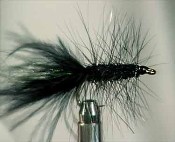 .. The Woolly Bugger is mandatory. This staple of most fly boxes is most popular in black, (dark green, olive, brown, gray, and even yellow are also seen.) With the advent of synthetic materials, this fly has many variants. We usually stick with black or olive and occasionally add just a bit of flash to the body. Sometimes a few strands creep into the marabou fibres too.
.. The Woolly Bugger is mandatory. This staple of most fly boxes is most popular in black, (dark green, olive, brown, gray, and even yellow are also seen.) With the advent of synthetic materials, this fly has many variants. We usually stick with black or olive and occasionally add just a bit of flash to the body. Sometimes a few strands creep into the marabou fibres too. .. The Quick-N-Easy seems to be limited to the Lamar River, the upper Gibbon River, the Yellowstone River, and infrequently it is seen on Slough Creek below the parking lot, and along the road section. This is probably a cultural difference in feather merchant preference as much as a trout preference. We use it on the Gallatin River and the Madison River and it works just fine. The fly goes together quickly and is very durable. Just one kind of feather - two kinds of floss - one color thread.
.. The Quick-N-Easy seems to be limited to the Lamar River, the upper Gibbon River, the Yellowstone River, and infrequently it is seen on Slough Creek below the parking lot, and along the road section. This is probably a cultural difference in feather merchant preference as much as a trout preference. We use it on the Gallatin River and the Madison River and it works just fine. The fly goes together quickly and is very durable. Just one kind of feather - two kinds of floss - one color thread.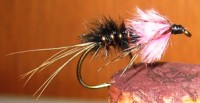
 .. The Feather Duster is almost a lost tradition in Yellowstone Fishing. The original was actually made from the material in feather dusters. It has some color variants. Tied in the smaller sizes this is a very effective spring and summer nymph. The larger yellow and especially pink versions are frequently just the thing that late Fall migrating spawners are looking for.
.. The Feather Duster is almost a lost tradition in Yellowstone Fishing. The original was actually made from the material in feather dusters. It has some color variants. Tied in the smaller sizes this is a very effective spring and summer nymph. The larger yellow and especially pink versions are frequently just the thing that late Fall migrating spawners are looking for.
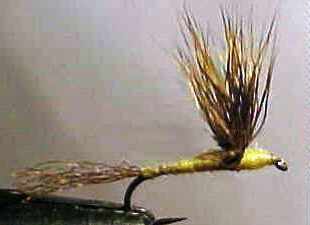
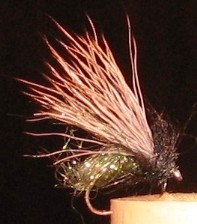 The fall hatches in Yellowstone can range from apparent to negligible - they don't ever seem to be spectacular, (save for the occasional "snow fly" marathon.) The Caddis is the one we use most, followed by the cinch, then the BWO, (which will do if the Baetis appear.)
The fall hatches in Yellowstone can range from apparent to negligible - they don't ever seem to be spectacular, (save for the occasional "snow fly" marathon.) The Caddis is the one we use most, followed by the cinch, then the BWO, (which will do if the Baetis appear.).. The continuing expanded use of Soft Hackle Flies in Yellowstone and elsewhere is a testament to their effective deployment in sunken fly fishing. It is probably also a testament to their ease of construction.
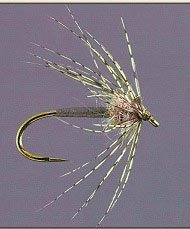
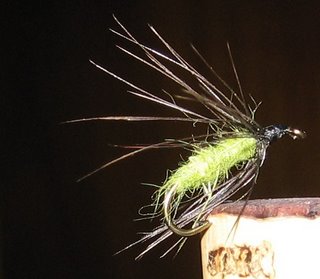 And, tied correctly, they are surprisingly durable. The stiff hackle variant is less well known and probably less effective for Fall fishing. We only use two colors and several sizes of this endearing fly: The Classic Version with barred hackle, and the Green Thing with dark furnace or black hackle.
And, tied correctly, they are surprisingly durable. The stiff hackle variant is less well known and probably less effective for Fall fishing. We only use two colors and several sizes of this endearing fly: The Classic Version with barred hackle, and the Green Thing with dark furnace or black hackle.
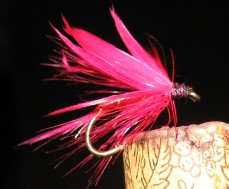 .. Wet flies and others tend to overlap in use and definition. In the summer we float a Hornberg and pretend that it's a hopper. In the Fall we sink it and pretend it's a wet fly. We also use a Scarlet Ibis with magenta feathers and sometimes a gold rib. The double wings of the early traditional patterns separate and become a large bright mass. The fish don't seem to mind, (or even prefer it?)
.. Wet flies and others tend to overlap in use and definition. In the summer we float a Hornberg and pretend that it's a hopper. In the Fall we sink it and pretend it's a wet fly. We also use a Scarlet Ibis with magenta feathers and sometimes a gold rib. The double wings of the early traditional patterns separate and become a large bright mass. The fish don't seem to mind, (or even prefer it?).. Yellowstone National Park Fishing Regulations, (page 6,) "Open daily from 5 AM to 10 PM. Fishing with an artificial light is prohibited." This means that there is at least 4, and later, nearly 6 hours of fishing in the dark or near dark.
.. For these situations it is possible to take some very large fish on a mouse. YES - A MOUSE! or any other large floating fly that can make a ruckus in the areas that fish hide. This is not stealth fishing - this is bomb and boil fishing. We occasionally end our day by cutting back the leader to obscene dimensions and slowly probing the bank with a bass popper or a mouse, (the mice are traditional - use chamois for the ears and tail - rubber whiskers - eyes and colors are optional.) Big trout eat baby ducks; - voles, shrews, and mice too.
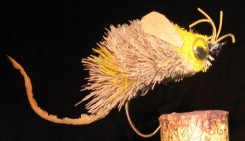 .
.OOPS, as we were taking a break from this post we noticed that Mid Current also referes us to a post about Mice from Michigan.
Check the "TIP 'O THE WEEK" for the neighbor's secrets.



